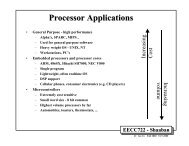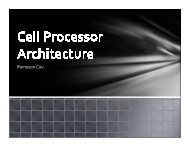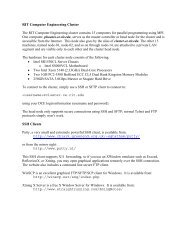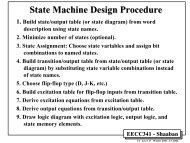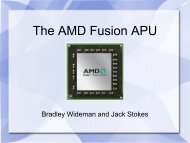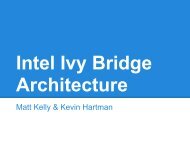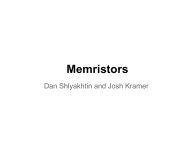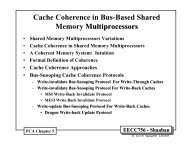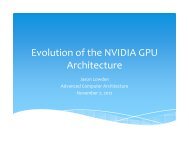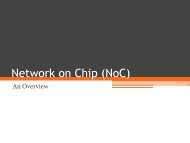EECC550 - Shaaban
EECC550 - Shaaban
EECC550 - Shaaban
Create successful ePaper yourself
Turn your PDF publications into a flip-book with our unique Google optimized e-Paper software.
MIPS Integer ALU Requirements<br />
• Add, AddU, Sub, SubU, AddI, AddIU:<br />
•<br />
→ 2’s complement adder/sub with overflow detection.<br />
• And, Or, Andi, Ori, Xor, Xori, Nor:<br />
→ Logical AND, logical OR, XOR, nor.<br />
• SLTI, SLTIU (set less than):<br />
→ 2’s complement adder with inverter, check sign bit of<br />
result.<br />
<strong>EECC550</strong> - <strong>Shaaban</strong><br />
#1 Lec # 7 Winter 2001 1-31-2002
MIPS Arithmetic Instructions<br />
Instruction Example Meaning Comments<br />
add add $1,$2,$3 $1 = $2 + $3 3 operands; exception possible<br />
subtract sub $1,$2,$3 $1 = $2 – $3 3 operands; exception possible<br />
add immediate addi $1,$2,100 $1 = $2 + 100 + constant; exception possible<br />
add unsigned addu $1,$2,$3 $1 = $2 + $3 3 operands; no exceptions<br />
subtract unsigned subu $1,$2,$3 $1 = $2 – $3 3 operands; no exceptions<br />
add imm. unsign. addiu $1,$2,100 $1 = $2 + 100 + constant; no exceptions<br />
multiply mult $2,$3 Hi, Lo = $2 x $3 64-bit signed product<br />
multiply unsigned multu$2,$3 Hi, Lo = $2 x $3 64-bit unsigned product<br />
divide div $2,$3 Lo = $2 ÷ $3, Lo = quotient, Hi = remainder<br />
Hi = $2 mod $3<br />
divide unsigned divu $2,$3 Lo = $2 ÷ $3, Unsigned quotient & remainder<br />
Hi = $2 mod $3<br />
Move from Hi mfhi $1 $1 = Hi Used to get copy of Hi<br />
Move from Lo mflo $1 $1 = Lo Used to get copy of Lo<br />
<strong>EECC550</strong> - <strong>Shaaban</strong><br />
#2 Lec # 7 Winter 2001 1-31-2002
MIPS Arithmetic Instruction Format<br />
R-type:<br />
I-Type:<br />
31 25 20 15 5 0<br />
op Rs Rt Rd funct<br />
op Rs Rt Immed 16<br />
Type op funct<br />
ADDI 10 xx<br />
ADDIU 11 xx<br />
SLTI 12 xx<br />
SLTIU 13 xx<br />
ANDI 14 xx<br />
ORI 15 xx<br />
XORI 16 xx<br />
LUI 17 xx<br />
Type op funct<br />
ADD 00 40<br />
ADDU 00 41<br />
SUB 00 42<br />
SUBU 00 43<br />
AND 00 44<br />
OR 00 45<br />
XOR 00 46<br />
NOR 00 47<br />
Type op funct<br />
00 50<br />
00 51<br />
SLT 00 52<br />
SLTU 00 53<br />
<strong>EECC550</strong> - <strong>Shaaban</strong><br />
#3 Lec # 7 Winter 2001 1-31-2002
MIPS Integer ALU Requirements<br />
(1) Functional Specification:<br />
inputs: 2 x 32-bit operands A, B, 4-bit mode<br />
outputs: 32-bit result S, 1-bit carry, 1 bit overflow, 1 bit zero<br />
operations: add, addu, sub, subu, and, or, xor, nor, slt, sltU<br />
(2) Block Diagram:<br />
c<br />
A<br />
zero<br />
ovf<br />
32 32<br />
ALU<br />
S<br />
32<br />
B<br />
10 operations<br />
thus 4 control bits<br />
m<br />
4<br />
00 add<br />
01 addU<br />
02 sub<br />
03 subU<br />
04 and<br />
05 or<br />
06 xor<br />
07 nor<br />
12 slt<br />
13 sltU<br />
<strong>EECC550</strong> - <strong>Shaaban</strong><br />
#4 Lec # 7 Winter 2001 1-31-2002
Building Block: 1-bit Full Adder<br />
CarryIn<br />
A<br />
B<br />
1-bit<br />
Full<br />
Adder<br />
Sum<br />
CarryOut<br />
2 gate delay for sum<br />
3 gate delay for carry out 2 gate delay version for carry out<br />
<strong>EECC550</strong> - <strong>Shaaban</strong><br />
#5 Lec # 7 Winter 2001 1-31-2002
Building Block: 1-bit ALU<br />
Performs: AND, OR,<br />
addition on A, B or A, B inverted<br />
A<br />
invertB<br />
CarryIn<br />
and<br />
Operation<br />
or<br />
Mux<br />
Result<br />
B<br />
1-bit<br />
Full<br />
Adder<br />
add<br />
CarryOut<br />
<strong>EECC550</strong> - <strong>Shaaban</strong><br />
#6 Lec # 7 Winter 2001 1-31-2002
32-Bit ALU Using 32 1-Bit ALUs<br />
A0<br />
B0<br />
A31<br />
B31<br />
CarryIn0<br />
CarryIn1<br />
A1<br />
B1<br />
CarryIn2<br />
A2<br />
B2<br />
CarryIn3<br />
CarryIn31<br />
1-bit<br />
ALU<br />
1-bit<br />
ALU<br />
1-bit<br />
ALU<br />
:<br />
:<br />
1-bit<br />
ALU<br />
CarryOut0<br />
CarryOut1<br />
CarryOut30<br />
Result0<br />
Result1<br />
Result2<br />
Result31<br />
32-bit rippled-carry adder<br />
(operation/invertB lines not shown)<br />
Addition/Subtraction Performance:<br />
Total delay = 32 x (1-Bit ALU Delay)<br />
= 32 x 2 x gate delay<br />
= 64 x gate delay<br />
C<br />
CarryOut31<br />
<strong>EECC550</strong> - <strong>Shaaban</strong><br />
#7 Lec # 7 Winter 2001 1-31-2002
Adding Overflow/Zero Detection Logic<br />
• For a N-bit ALU: Overflow = CarryIn[N - 1] XOR CarryOut[N - 1]<br />
CarryIn0<br />
A0<br />
B0<br />
CarryIn1<br />
A1<br />
B1<br />
CarryIn2<br />
A2<br />
B2<br />
A31<br />
B31<br />
CarryIn3<br />
CarryIn31<br />
1-bit<br />
ALU<br />
1-bit<br />
ALU<br />
1-bit<br />
ALU<br />
1-bit<br />
ALU<br />
CarryOut0<br />
CarryOut1<br />
:<br />
: CarryOut30<br />
Result0<br />
Result1<br />
Result2<br />
:<br />
:<br />
:<br />
:<br />
Result31<br />
Zero<br />
Overflow<br />
C<br />
CarryOut31<br />
<strong>EECC550</strong> - <strong>Shaaban</strong><br />
#8 Lec # 7 Winter 2001 1-31-2002
Modified<br />
1-Bit ALU<br />
Adding Support For SLT<br />
• In SLT if A < B , the least significant result bit is set to 1.<br />
• Perform A - B, A < B if sign bit is 1<br />
– Use sign bit as Result0 setting all other result bits to zero.<br />
A<br />
invertB<br />
CarryIn<br />
and<br />
Operation<br />
invertB<br />
Control values:<br />
000 = and<br />
001 = or<br />
010 = add<br />
110 = subtract<br />
111 = slt<br />
Operation<br />
MUX select<br />
B<br />
Less<br />
position 0: connected to sign bit, Result31<br />
positions 1-31: set to 0<br />
CarryOut<br />
1-bit<br />
Full<br />
Adder<br />
or<br />
add<br />
slt<br />
Mux<br />
Result<br />
<strong>EECC550</strong> - <strong>Shaaban</strong><br />
#9 Lec # 7 Winter 2001 1-31-2002
MIPS ALU With SLT Support Added<br />
CarryIn0<br />
Less<br />
A0<br />
B0<br />
A1<br />
B1<br />
Less = 0<br />
A2<br />
B2<br />
Less = 0<br />
1-bit Result0<br />
ALU<br />
CarryIn1 CarryOut0<br />
1-bit Result1<br />
ALU<br />
CarryIn2 CarryOut1<br />
CarryIn3<br />
CarryIn31<br />
1-bit<br />
ALU<br />
A31<br />
B31 1-bit<br />
Less = 0 ALU<br />
CarryOut31<br />
C<br />
:<br />
:<br />
CarryOut30<br />
Result2<br />
:<br />
:<br />
:<br />
:<br />
Result31<br />
Zero<br />
Overflow<br />
<strong>EECC550</strong> - <strong>Shaaban</strong><br />
#10 Lec # 7 Winter 2001 1-31-2002
Improving ALU Performance:<br />
Carry Look Ahead (CLA)<br />
A0<br />
B1<br />
A<br />
B<br />
A<br />
B<br />
A<br />
B<br />
G<br />
P<br />
G<br />
P<br />
G<br />
P<br />
G<br />
P<br />
Cin<br />
S<br />
S<br />
S<br />
S<br />
C1 =G0 + C0 • P0<br />
C2 = G1 + G0 • P1 + C0 • P0 • P1<br />
A B C-out<br />
0 0 0 “kill”<br />
0 1 C-in “propagate”<br />
1 0 C-in “propagate”<br />
1 1 1 “generate”<br />
G = A and B<br />
P = A xor B<br />
C3 = G2 + G1 • P2 + G0 • P1 • P2 + C0 • P0 • P1 • P2<br />
G<br />
P<br />
C4 = . . .<br />
<strong>EECC550</strong> - <strong>Shaaban</strong><br />
#11 Lec # 7 Winter 2001 1-31-2002
C<br />
L<br />
A<br />
4-bit<br />
Adder<br />
4-bit<br />
Adder<br />
4-bit<br />
Adder<br />
Cascaded Carry Look-ahead<br />
C0<br />
G0<br />
P0<br />
C1 =G0 + C0 • P0<br />
{<br />
C2 = G1 + G0 • P1 + C0 • P0 • P1<br />
16-Bit Example<br />
Delay = 2 + 2 + 1 = 5 gate delays<br />
C3 = G2 + G1 • P2 + G0 • P1 • P2 + C0 • P0 • P1 • P2<br />
G<br />
P<br />
Assuming all<br />
gates have<br />
equal delay<br />
C4 = . . .<br />
<strong>EECC550</strong> - <strong>Shaaban</strong><br />
#12 Lec # 7 Winter 2001 1-31-2002
Additional MIPS ALU requirements<br />
• Mult, MultU, Div, DivU:<br />
=> Need 32-bit multiply and divide, signed and unsigned.<br />
• Sll, Srl, Sra:<br />
=> Need left shift, right shift, right shift arithmetic by 0 to 31<br />
• Nor:<br />
bits.<br />
=> logical NOR to be added.<br />
<strong>EECC550</strong> - <strong>Shaaban</strong><br />
#13 Lec # 7 Winter 2001 1-31-2002
Unsigned Multiplication Example<br />
• Paper and pencil example (unsigned):<br />
Multiplicand 1000<br />
Multiplier 1001<br />
1000<br />
0000<br />
0000<br />
1000<br />
Product 01001000<br />
• m bits x n bits = m + n bit product, m = 32, n = 32, 64 bit product.<br />
• The binary number system simplifies multiplication:<br />
0 => place 0 ( 0 x multiplicand).<br />
1 => place a copy ( 1 x multiplicand).<br />
• We will examine 4 versions of multiplication hardware & algorithm:<br />
–Successive refinement of design.<br />
<strong>EECC550</strong> - <strong>Shaaban</strong><br />
#14 Lec # 7 Winter 2001 1-31-2002
An Unsigned Combinational Multiplier<br />
4-bit adder<br />
0 0 0 0<br />
A 3 A 2 A 1 A 0<br />
A 3 A 2 A 1 A 0<br />
A 3 A 2 A 1 A 0<br />
A 2 A 1 A 0<br />
P 7 P 6 P 5 P 4 P 3 P 2 P 1 P 0<br />
4 x 4 multiplier<br />
A 3<br />
B 1<br />
B 2<br />
• Stage i accumulates A * 2 i if B i<br />
== 1<br />
• How much hardware for a 32-bit multiplier? Critical path?<br />
B 0<br />
B 3<br />
<strong>EECC550</strong> - <strong>Shaaban</strong><br />
#15 Lec # 7 Winter 2001 1-31-2002
Operation of Combinational Multiplier<br />
0 0 0 0 0 0 0<br />
P 7 P 6 P 5 P 4 P 3 P 2 P 1 P 0<br />
A 3 A 2 A 1 A 0<br />
A 3 A 2 A 1 A 0<br />
A 3 A 2 A 1 A 0<br />
A 2 A 1 A 0<br />
A 3<br />
B 1<br />
B 2<br />
B 0<br />
B 3<br />
• At each stage shift A left ( x 2).<br />
• Use next bit of B to determine whether to add in shifted multiplicand.<br />
• Accumulate 2n bit partial product at each stage.<br />
<strong>EECC550</strong> - <strong>Shaaban</strong><br />
#16 Lec # 7 Winter 2001 1-31-2002
Unsigned Shift-Add Multiplier (version 1)<br />
• 64-bit Multiplicand register.<br />
• 64-bit ALU.<br />
• 64-bit Product register.<br />
• 32-bit multiplier register.<br />
Multiplicand<br />
64 bits<br />
Shift Left<br />
64-bit ALU<br />
Multiplier<br />
32 bits<br />
Shift Right<br />
Product<br />
64 bits<br />
Write<br />
Control<br />
Multiplier = datapath + control<br />
<strong>EECC550</strong> - <strong>Shaaban</strong><br />
#17 Lec # 7 Winter 2001 1-31-2002
Multiply Algorithm<br />
Version 1<br />
Multiplier0 = 1<br />
Start<br />
1. Test<br />
Multiplier0<br />
Multiplier0 = 0<br />
1a. Add multiplicand to product &<br />
place the result in Product register<br />
2. Shift the Multiplicand register left 1 bit.<br />
3. Shift the Multiplier register right 1 bit.<br />
Product Multiplier Multiplicand<br />
0000 0000 0011 0000 0010<br />
0000 0010 0001 0000 0100<br />
0000 0110 0000 0000 1000<br />
0000 0110<br />
32nd<br />
repetition?<br />
No: < 32 repetitions<br />
Yes: 32 repetitions<br />
Done<br />
<strong>EECC550</strong> - <strong>Shaaban</strong><br />
#18 Lec # 7 Winter 2001 1-31-2002
MULTIPLY HARDWARE Version 2<br />
• Instead of shifting multiplicand to left, shift product to right:<br />
– 32-bit Multiplicand register.<br />
– 32 -bit ALU.<br />
– 64-bit Product register.<br />
– 32-bit Multiplier register.<br />
Multiplicand<br />
32-bit ALU<br />
32 bits<br />
Multiplier<br />
32 bits<br />
Shift Right<br />
Product<br />
64 bits<br />
Shift Right<br />
Write<br />
Control<br />
<strong>EECC550</strong> - <strong>Shaaban</strong><br />
#19 Lec # 7 Winter 2001 1-31-2002
Multiply Algorithm<br />
Version 2<br />
Multiplier0 = 1<br />
Start<br />
1. Test<br />
Multiplier0<br />
Multiplier0 = 0<br />
1a. Add multiplicand to the left half of product &<br />
place the result in the left half of Product register<br />
Product<br />
Multiplier Multiplicand<br />
0000 0000 0011 0010<br />
0010 0000<br />
0001 0000 0001 0010<br />
0011 00 0001 0010<br />
0001 1000 0000 0010<br />
0000 1100 0000 0010<br />
0000 0110 0000 0010<br />
2. Shift the Product register right 1 bit.<br />
3. Shift the Multiplier register right 1 bit.<br />
32nd<br />
repetition?<br />
No: < 32 repetitions<br />
Yes: 32 repetitions<br />
Done<br />
<strong>EECC550</strong> - <strong>Shaaban</strong><br />
#20 Lec # 7 Winter 2001 1-31-2002
Multiplication Version 2 Operation<br />
0 0 0 0<br />
A 3 A 2 A 1 A 0<br />
A 3 A 2 A 1 A 0<br />
A 3 A 2 A 1 A 0<br />
A 3 A 2 A 1 A 0<br />
P 7<br />
P 6<br />
• Multiplicand stays still and product moves right.<br />
P 5<br />
P 4<br />
P 3<br />
P 2<br />
P 1<br />
B 0<br />
B 1<br />
B 2<br />
B 3<br />
P 0<br />
<strong>EECC550</strong> - <strong>Shaaban</strong><br />
#21 Lec # 7 Winter 2001 1-31-2002
MULTIPLY HARDWARE Version 3<br />
• Combine Multiplier register and Product register:<br />
– 32-bit Multiplicand register.<br />
– 32 -bit ALU.<br />
– 64-bit Product register, (0-bit Multiplier register).<br />
Multiplicand<br />
32 bits<br />
32-bit ALU<br />
Product (Multiplier)<br />
64 bits<br />
Shift Right<br />
Write<br />
Control<br />
<strong>EECC550</strong> - <strong>Shaaban</strong><br />
#22 Lec # 7 Winter 2001 1-31-2002
Multiply Algorithm<br />
Version 3<br />
Product0 = 1<br />
Start<br />
1. Test<br />
Product0<br />
Product0 = 0<br />
1a. Add multiplicand to the left half of product &<br />
place the result in the left half of Product register<br />
2. Shift the Product register right 1 bit.<br />
32nd<br />
repetition?<br />
No: < 32 repetitions<br />
Yes: 32 repetitions<br />
Done<br />
<strong>EECC550</strong> - <strong>Shaaban</strong><br />
#23 Lec # 7 Winter 2001 1-31-2002
Observations on Multiply Version 3<br />
• 2 steps per bit because Multiplier & Product are combined.<br />
• MIPS registers Hi and Lo are left and right halves of Product.<br />
• Provides the MIPS instruction MultU.<br />
• What about signed multiplication?<br />
– The easiest solution is to make both positive & remember<br />
whether to complement product when done (leave out the sign<br />
bit, run for 31 steps).<br />
– Apply definition of 2’s complement:<br />
• Need to sign-extend partial products and subtract at the end.<br />
– Booth’s Algorithm is an elegant way to multiply signed numbers<br />
using the same hardware as before and save cycles:<br />
• Can handle multiple bits at a time.<br />
<strong>EECC550</strong> - <strong>Shaaban</strong><br />
#24 Lec # 7 Winter 2001 1-31-2002
Motivation for Booth’s Algorithm<br />
• Example 2 x 6 = 0010 x 0110:<br />
0010<br />
x 0110<br />
+ 0000 shift (0 in multiplier)<br />
+ 0010 add (1 in multiplier)<br />
+ 0100 add (1 in multiplier)<br />
+ 0000 shift (0 in multiplier)<br />
00001100<br />
• An ALU with add or subtract gets the same result in more than one way:<br />
6 = – 2 + 8<br />
0110 = – 00010 + 01000 = 11110 + 01000<br />
• For example:<br />
0010<br />
x 0110<br />
0000 shift (0 in multiplier)<br />
– 0010 sub (first 1 in multpl.) .<br />
0000 shift (mid string of 1s) .<br />
+ 0010 add (prior step had last 1)<br />
00001100<br />
<strong>EECC550</strong> - <strong>Shaaban</strong><br />
#25 Lec # 7 Winter 2001 1-31-2002
Booth’s Algorithm<br />
end of run<br />
middle of run<br />
0 1 1 1 1 0<br />
beginning of run<br />
Current Bit Bit to the Right Explanation Example Op<br />
1 0 Begins run of 1s 0001111000 sub<br />
1 1 Middle of run of 1s 0001111000 none<br />
0 1 End of run of 1s 0001111000 add<br />
0 0 Middle of run of 0s 0001111000 none<br />
• Originally designed for Speed (when shift was faster than add).<br />
• Replace a string of 1s in multiplier with an initial subtract when we first<br />
see a one and then later add for the bit after the last one.<br />
<strong>EECC550</strong> - <strong>Shaaban</strong><br />
#26 Lec # 7 Winter 2001 1-31-2002
Booth Example (2 x 7)<br />
Operation Multiplicand Product next?<br />
0. initial value 0010 0000 0111 0 10 -> sub<br />
1a. P = P - m 1110 + 1110<br />
1110 0111 0 shift P (sign ext)<br />
1b. 0010 1111 0011 1 11 -> nop, shift<br />
2. 0010 1111 1001 1 11 -> nop, shift<br />
3. 0010 1111 1100 1 01 -> add<br />
4a. 0010 + 0010<br />
0001 1100 1 shift<br />
4b. 0010 0000 1110 0 done<br />
<strong>EECC550</strong> - <strong>Shaaban</strong><br />
#27 Lec # 7 Winter 2001 1-31-2002
Booth Example (2 x -3)<br />
Operation Multiplicand Product next?<br />
0. initial value 0010 0000 1101 0 10 -> sub<br />
1a. P = P - m 1110 + 1110<br />
1110 1101 0 shift P (sign ext)<br />
1b. 0010 1111 0110 1 01 -> add<br />
+ 0010<br />
2a. 0001 0110 1 shift P<br />
2b. 0010 0000 1011 0 10 -> sub<br />
+ 1110<br />
3a. 0010 1110 1011 0 shift<br />
3b. 0010 1111 0101 1 11 -> nop<br />
4a 1111 0101 1 shift<br />
4b. 0010 1111 1010 1 done<br />
<strong>EECC550</strong> - <strong>Shaaban</strong><br />
#28 Lec # 7 Winter 2001 1-31-2002
MIPS Logical Instructions<br />
Instruction Example Meaning Comment<br />
and and $1,$2,$3 $1 = $2 & $3 3 reg. operands; Logical AND<br />
or or $1,$2,$3 $1 = $2 | $3 3 reg. operands; Logical OR<br />
xor xor $1,$2,$3 $1 = $2 ¯ $3 3 reg. operands; Logical XOR<br />
nor nor $1,$2,$3 $1 = ~($2 |$3) 3 reg. operands; Logical NOR<br />
and immediate andi $1,$2,10 $1 = $2 & 10 Logical AND reg, constant<br />
or immediate ori $1,$2,10 $1 = $2 | 10 Logical OR reg, constant<br />
xor immediate xori $1, $2,10 $1 = ~$2 &~10 Logical XOR reg, constant<br />
shift left logical sll $1,$2,10 $1 = $2 > 10 Shift right by constant<br />
shift right arithm. sra $1,$2,10 $1 = $2 >> 10 Shift right (sign extend)<br />
shift left logical sllv $1,$2,$3 $1 = $2 > $3 Shift right by variable<br />
shift right arithm. srav $1,$2, $3 $1 = $2 >> $3 Shift right arith. by variable<br />
<strong>EECC550</strong> - <strong>Shaaban</strong><br />
#29 Lec # 7 Winter 2001 1-31-2002
Combinational Shifter from MUXes<br />
Basic Building Block<br />
sel<br />
A<br />
B<br />
1 0<br />
8-bit right shifter<br />
D<br />
A 6<br />
A 5<br />
A 4<br />
A 3<br />
A 2<br />
A 1<br />
A 0<br />
S 2 S 1 S 0<br />
1 0 1 0 1 0 1 0 1 0 1 0 1 0 1 0<br />
1 0 1 0 1 0 1 0 1 0 1 0 1 0 1 0<br />
1 0 1 0 1 0 1 0 1 0 1 0 1 0 1 0<br />
R 7<br />
A 7<br />
R 0<br />
R 6<br />
R 5<br />
R 4<br />
R 3<br />
R 2<br />
R 1<br />
• What comes in the MSBs?<br />
• How many levels for 32-bit shifter?<br />
<strong>EECC550</strong> - <strong>Shaaban</strong><br />
#30 Lec # 7 Winter 2001 1-31-2002
General Shift Right Scheme Using 16-Bit Example<br />
S 0<br />
(0,1)<br />
S 1<br />
(0, 2)<br />
S 2<br />
(0, 4)<br />
S 3<br />
(0, 8)<br />
If added Right-to-left connections could<br />
support Rotate (not in MIPS but found in ISAs)<br />
<strong>EECC550</strong> - <strong>Shaaban</strong><br />
#31 Lec # 7 Winter 2001 1-31-2002
Barrel Shifter<br />
Technology-dependent solution: a transistor per switch<br />
SR3 SR2 SR1 SR0<br />
D3<br />
A6<br />
D2<br />
A5<br />
D1<br />
A4<br />
D0<br />
A3 A2 A1 A0<br />
<strong>EECC550</strong> - <strong>Shaaban</strong><br />
#32 Lec # 7 Winter 2001 1-31-2002
Division<br />
1001 Quotient<br />
Divisor 1000 1001010 Dividend<br />
–1000<br />
10<br />
101<br />
1010<br />
–1000<br />
10 Remainder (or Modulo result)<br />
• See how big a number can be subtracted, creating quotient bit on each step:<br />
Binary =><br />
1 * divisor or 0 * divisor<br />
Dividend = Quotient x Divisor + Remainder<br />
=> | Dividend | = | Quotient | + | Divisor |<br />
• 3 versions of divide, successive refinement<br />
<strong>EECC550</strong> - <strong>Shaaban</strong><br />
#33 Lec # 7 Winter 2001 1-31-2002
DIVIDE HARDWARE Version 1<br />
• 64-bit Divisor register.<br />
• 64-bit ALU.<br />
• 64-bit Remainder register.<br />
• 32-bit Quotient register.<br />
Divisor<br />
64 bits<br />
Shift Right<br />
64-bit ALU<br />
Quotient<br />
32 bits<br />
Shift Left<br />
Remainder<br />
64 bits<br />
Write<br />
Control<br />
<strong>EECC550</strong> - <strong>Shaaban</strong><br />
#34 Lec # 7 Winter 2001 1-31-2002
Divide Algorithm<br />
Version 1<br />
Takes n+1 steps for n-bit<br />
Quotient & Rem.<br />
Remainder >= 0<br />
Start: Place Dividend in Remainder<br />
1. Subtract the Divisor register from the<br />
Remainder register, and place the result<br />
in the Remainder register.<br />
Test<br />
Remainder<br />
Remainder < 0<br />
2a. Shift the<br />
Quotient register<br />
to the left setting<br />
the new rightmost<br />
bit to 1.<br />
2b. Restore the original value by adding the<br />
Divisor register to the Remainder register, &<br />
place the sum in the Remainder register. Also<br />
shift the Quotient register to the left, setting<br />
the new least significant bit to 0.<br />
3. Shift the Divisor register right1 bit.<br />
n+1<br />
repetition?<br />
Done<br />
No: < n+1 repetitions<br />
Yes: n+1 repetitions (n = 4 here)<br />
<strong>EECC550</strong> - <strong>Shaaban</strong><br />
#35 Lec # 7 Winter 2001 1-31-2002
Observations on Divide Version 1<br />
• 1/2 bits in divisor are always 0.<br />
=> 1/2 of 64-bit adder is wasted.<br />
=> 1/2 of divisor is wasted.<br />
• Instead of shifting divisor to right,<br />
shift remainder to left?<br />
• 1st step cannot produce a 1 in quotient bit<br />
(otherwise too big).<br />
=> Switch order to shift first and then subtract,<br />
can save 1 iteration.<br />
<strong>EECC550</strong> - <strong>Shaaban</strong><br />
#36 Lec # 7 Winter 2001 1-31-2002
DIVIDE HARDWARE Version 2<br />
• 32-bit Divisor register.<br />
• 32-bit ALU.<br />
• 64-bit Remainder register.<br />
• 32-bit Quotient register.<br />
Divisor<br />
32-bit ALU<br />
32 bits<br />
Quotient<br />
32 bits<br />
Shift Left<br />
Remainder<br />
64 bits<br />
Shift Left<br />
Write<br />
Control<br />
<strong>EECC550</strong> - <strong>Shaaban</strong><br />
#37 Lec # 7 Winter 2001 1-31-2002
Divide Algorithm<br />
Version 2<br />
Start: Place Dividend in Remainder<br />
1. Shift the Remainder register left 1 bit.<br />
2. Subtract the Divisor register from the<br />
left half of the Remainder register, & place the<br />
result in the left half of the Remainder register.<br />
Remainder >= 0<br />
Test<br />
Remainder<br />
Remainder < 0<br />
3a. Shift the<br />
Quotient register<br />
to the left setting<br />
the new rightmost<br />
bit to 1.<br />
3b. Restore the original value by adding the Divisor<br />
register to the left half of the Remainderregister,<br />
&place the sum in the left half of the Remainder<br />
register. Also shift the Quotient register to the left,<br />
setting the new least significant bit to 0.<br />
nth<br />
repetition?<br />
Done<br />
No: < n repetitions<br />
Yes: n repetitions (n = 4 here)<br />
<strong>EECC550</strong> - <strong>Shaaban</strong><br />
#38 Lec # 7 Winter 2001 1-31-2002
Observations on Divide Version 2<br />
• Eliminate Quotient register by combining with<br />
Remainder as shifted left:<br />
– Start by shifting the Remainder left as before.<br />
– Thereafter loop contains only two steps because the<br />
shifting of the Remainder register shifts both the<br />
remainder in the left half and the quotient in the right half.<br />
– The consequence of combining the two registers together<br />
and the new order of the operations in the loop is that the<br />
remainder will shifted left one time too many.<br />
– Thus the final correction step must shift back only the<br />
remainder in the left half of the register.<br />
<strong>EECC550</strong> - <strong>Shaaban</strong><br />
#39 Lec # 7 Winter 2001 1-31-2002
DIVIDE HARDWARE Version 3<br />
• 32-bit Divisor register.<br />
• 32 -bit ALU.<br />
• 64-bit Remainder register (0-bit Quotient register).<br />
Divisor<br />
32 bits<br />
32-bit ALU<br />
“HI”<br />
“LO”<br />
Remainder (Quotient)<br />
64 bits<br />
Shift Left<br />
Write<br />
Control<br />
<strong>EECC550</strong> - <strong>Shaaban</strong><br />
#40 Lec # 7 Winter 2001 1-31-2002
Divide Algorithm<br />
Version 3<br />
Start: Place Dividend in Remainder<br />
1. Shift the Remainder register left 1 bit.<br />
2. Subtract the Divisor register from the<br />
left half of the Remainder register, & place the<br />
result in the left half of the Remainder register.<br />
Remainder >= 0<br />
Test<br />
Remainder<br />
Remainder < 0<br />
3a. Shift the<br />
Remainder register<br />
to the left setting<br />
the new rightmost<br />
bit to 1.<br />
3b. Restore the original value by adding the Divisor<br />
register to the left half of the Remainderregister,<br />
&place the sum in the left half of the Remainder<br />
register. Also shift the Remainder register to the<br />
left, setting the new least significant bit to 0.<br />
nth<br />
repetition?<br />
No: < n repetitions<br />
Yes: n repetitions (n = 4 here)<br />
Done. Shift left half of Remainder right 1 bit.<br />
<strong>EECC550</strong> - <strong>Shaaban</strong><br />
#41 Lec # 7 Winter 2001 1-31-2002
Observations on Divide Version 3<br />
• Same Hardware as Multiply: Just requires an ALU to add or<br />
subtract, and 64-bit register to shift left or shift right.<br />
• Hi and Lo registers in MIPS combine to act as 64-bit register<br />
for multiply and divide.<br />
• Signed Divides: Simplest is to remember signs, make positive,<br />
and complement quotient and remainder if necessary.<br />
– Note:<br />
• Dividend and Remainder must have same sign.<br />
• Quotient negated if Divisor sign & Dividend sign disagree.<br />
• e.g., –7 ÷ 2 = –3, remainder = –1<br />
• Possible for quotient to be too large: If dividing a 64-bit<br />
integer by 1, quotient is 64 bits (“called saturation”).<br />
<strong>EECC550</strong> - <strong>Shaaban</strong><br />
#42 Lec # 7 Winter 2001 1-31-2002
Scientific Notation<br />
Decimal point<br />
Exponent<br />
25 -24<br />
5.04 x 10 - 1.673 x 10<br />
Mantissa<br />
Sign,<br />
Radix (base)<br />
Magnitude<br />
Sign, Magnitude<br />
<strong>EECC550</strong> - <strong>Shaaban</strong><br />
#43 Lec # 7 Winter 2001 1-31-2002
Representation of Floating Point Numbers in<br />
Single Precision IEEE 754 Standard<br />
Value = N = (-1) S X 2 E-127 X (1.M)<br />
0 < E < 255<br />
Actual exponent is:<br />
e = E - 127<br />
sign<br />
1 8 23<br />
S E M<br />
exponent:<br />
excess 127<br />
binary integer<br />
added<br />
mantissa:<br />
sign + magnitude, normalized<br />
binary significand with<br />
a hidden integer bit: 1.M<br />
Example: 0 = 0 00000000 0 . . . 0 -1.5 = 1 01111111 10 . . . 0<br />
Magnitude of numbers that<br />
can be represented is in the range: 2 -126 (1.0) to 2 127 (2 - 2 -23 )<br />
Which is approximately: 1.8 x 10 - 38 to 3.40 x 10 38<br />
<strong>EECC550</strong> - <strong>Shaaban</strong><br />
#44 Lec # 7 Winter 2001 1-31-2002
Representation of Floating Point Numbers in<br />
Double Precision IEEE 754 Standard<br />
Value = N = (-1) S X 2 E-1023 X (1.M)<br />
0 < E < 2047<br />
Actual exponent is:<br />
e = E - 1023<br />
sign<br />
1 11 52<br />
S E M<br />
exponent:<br />
excess 1023<br />
binary integer<br />
added<br />
Mantissa:<br />
sign + magnitude, normalized<br />
binary significand with<br />
a hidden integer bit: 1.M<br />
Example: 0 = 0 00000000000 0 . . . 0 -1.5 = 1 01111111111 10 . . . 0<br />
Magnitude of numbers that<br />
can be represented is in the range: 2 -1022 (1.0) to 2 1023 (2 - 2 - 52 )<br />
Which is approximately: 2.23 x 10 - 308 to 1.8 x 10 308<br />
<strong>EECC550</strong> - <strong>Shaaban</strong><br />
#45 Lec # 7 Winter 2001 1-31-2002
IEEE 754 Special Number Representation<br />
Single Precision Double Precision Number Represented<br />
Exponent Significand Exponent Significand<br />
0 0 0 0 0<br />
0 nonzero 0 nonzero Denormalized number 1<br />
1 to 254 anything 1 to 2046 anything Floating Point Number<br />
255 0 2047 0 Infinity 2<br />
255 nonzero 2047 nonzero NaN (Not A Number) 3<br />
1<br />
May be returned as a result of underflow in multiplication<br />
2<br />
Positive divided by zero yields “infinity”<br />
3<br />
Zero divide by zero yields NaN “not a number”<br />
<strong>EECC550</strong> - <strong>Shaaban</strong><br />
#46 Lec # 7 Winter 2001 1-31-2002
Floating Point Conversion Example<br />
• The decimal number .75 10 is to be represented in the<br />
IEEE 754 32-bit single precision format:<br />
Hidden<br />
.75 10 = 0.11 2 (converted to a binary number)<br />
= 1.1 x 2 -1 (normalized a binary number)<br />
• The mantissa is positive so the sign S is given by:<br />
S = 0<br />
• The biased exponent E is given by E = e + 127<br />
E = -1 + 127 = 126 10<br />
= 01111110 2<br />
• Fractional part of mantissa M:<br />
M = .10000000000000000000000 (in 23 bits)<br />
The IEEE 754 single precision representation is given by:<br />
0 01111110 10000000000000000000000<br />
S E M<br />
1 bit 8 bits 23 bits<br />
<strong>EECC550</strong> - <strong>Shaaban</strong><br />
#47 Lec # 7 Winter 2001 1-31-2002
Floating Point Conversion Example<br />
• The decimal number -2345.125 10 is to be represented in the<br />
IEEE 754 32-bit single precision format:<br />
-2345.125 10 = -100100101001.001 2 (converted to binary)<br />
Hidden<br />
= -1.00100101001001 x 2 11 (normalized binary)<br />
• The mantissa is negative so the sign S is given by:<br />
S = 1<br />
• The biased exponent E is given by E = e + 127<br />
E = 11 + 127 = 138 10<br />
= 10001010 2<br />
• Fractional part of mantissa M:<br />
M = .00100101001001000000000 (in 23 bits)<br />
The IEEE 754 single precision representation is given by:<br />
1 10001010 00100101001001000000000<br />
S E M<br />
1 bit 8 bits 23 bits<br />
<strong>EECC550</strong> - <strong>Shaaban</strong><br />
#48 Lec # 7 Winter 2001 1-31-2002
Basic Floating Point Addition Algorithm<br />
Assuming that the operands are already in the IEEE 754 format, performing floating<br />
point addition: Result = X + Y = (Xm x 2 Xe ) + (Ym x 2 Ye )<br />
involves the following steps:<br />
(1) Align binary point:<br />
• Initial result exponent: the larger of Xe, Ye<br />
• Compute exponent difference: Ye - Xe<br />
• If Ye > Xe Right shift Xm that many positions to form Xm 2 Xe-Ye<br />
• If Xe > Ye Right shift Ym that many positions to form Ym 2 Ye-Xe<br />
(2) Compute sum of aligned mantissas:<br />
i.e Xm2 Xe-Ye + Ym or Xm + Xm2 Ye-Xe<br />
(3) If normalization of result is needed, then a normalization step follows:<br />
• Left shift result, decrement result exponent (e.g., if result is 0.001xx…) or<br />
• Right shift result, increment result exponent (e.g., if result is 10.1xx…)<br />
Continue until MSB of data is 1 (NOTE: Hidden bit in IEEE Standard).<br />
(4) Doubly biased exponent must be corrected: extra subtraction step of the bias<br />
amount.<br />
(5) Check result exponent:<br />
• If larger than maximum exponent allowed return exponent overflow<br />
• If smaller than minimum exponent allowed return exponent underflow<br />
(6) Round the significand and re-normalize if needed. If result mantissa is 0, may<br />
need to set the exponent to zero by a special step to return a proper zero.<br />
<strong>EECC550</strong> - <strong>Shaaban</strong><br />
#49 Lec # 7 Winter 2001 1-31-2002
(1)<br />
Start<br />
Compare the exponents of the two numbers<br />
shift the smaller number to the right until its<br />
exponent matches the larger exponent<br />
Floating Point<br />
Addition<br />
Flowchart<br />
(2)<br />
Add the significands (mantissas)<br />
(3)<br />
Normalize the sum, either shifting right and<br />
incrementing the exponent or shifting left<br />
and decrementing the exponent<br />
No<br />
Still<br />
normalized?<br />
Done<br />
yes<br />
(4)<br />
Overflow or<br />
Underflow ?<br />
Generate exception<br />
or return error<br />
Round the significand to the appropriate number of bits<br />
If mantissa = 0, set exponent to 0<br />
(5)<br />
No<br />
Yes<br />
<strong>EECC550</strong> - <strong>Shaaban</strong><br />
#50 Lec # 7 Winter 2001 1-31-2002
Floating Point Addition Example<br />
• Add the following two numbers represented in the IEEE 754 single precision<br />
format: X = 2345.125 10<br />
represented as:<br />
0 10001010 00100101001001000000000<br />
to Y = .75 10<br />
represented as:<br />
0 01111110 10000000000000000000000<br />
(1) Align binary point:<br />
• Xe > Ye initial result exponent = Ye = 10001010 = 138 10<br />
• Xe - Ye = 10001010 - 01111110 = 00000110 = 12 10<br />
• Shift Ym 12 10 postions to the right to form<br />
Ym 2 Ye-Xe = Ym 2 -12 = 0.00000000000110000000000<br />
(2) Add mantissas:<br />
Xm + Ym 2 -12 = 1.00100101001001000000000<br />
+ 0.00000000000110000000000 =<br />
1. 00100101001111000000000<br />
(3) Normailzed? Yes<br />
(4) Overflow? No. Underflow? No (5) zero result? No<br />
Result 0 10001010 00100101001111000000000<br />
<strong>EECC550</strong> - <strong>Shaaban</strong><br />
#51 Lec # 7 Winter 2001 1-31-2002
IEEE 754 Single precision Addition Notes<br />
• If the exponents differ by more than 24, the smaller number will be shifted<br />
right entirely out of the mantissa field, producing a zero mantissa.<br />
– The sum will then equal the larger number.<br />
– Such truncation errors occur when the numbers differ by a factor of more than<br />
2 24 , which is approximately 1.6 x 10 7 .<br />
– Thus, the precision of IEEE single precision floating point arithmetic is<br />
approximately 7 decimal digits.<br />
• Negative mantissas are handled by first converting to 2's complement and<br />
then performing the addition.<br />
– After the addition is performed, the result is converted back to sign-magnitude<br />
form.<br />
• When adding numbers of opposite sign, cancellation may occur, resulting in<br />
a sum which is arbitrarily small, or even zero if the numbers are equal in<br />
magnitude.<br />
– Normalization in this case may require shifting by the total number of bits in the<br />
mantissa, resulting in a large loss of accuracy.<br />
• Floating point subtraction is achieved simply by inverting the sign bit and<br />
performing addition of signed mantissas as outlined above.<br />
<strong>EECC550</strong> - <strong>Shaaban</strong><br />
#52 Lec # 7 Winter 2001 1-31-2002
Floating Point Addition Hardware<br />
<strong>EECC550</strong> - <strong>Shaaban</strong><br />
#53 Lec # 7 Winter 2001 1-31-2002
Basic Floating Point Multiplication Algorithm<br />
Assuming that the operands are already in the IEEE 754 format, performing<br />
floating point multiplication:<br />
Result = R = X * Y = (-1) Xs (Xm x 2 Xe ) * (-1) Ys (Ym x 2 Ye )<br />
involves the following steps:<br />
(1) If one or both operands is equal to zero, return the result as zero, otherwise:<br />
(2) Compute the exponent of the result:<br />
Result exponent = biased exponent (X) + biased exponent (Y) - bias<br />
(3) Compute the sign of the result Xs XOR Ys<br />
(4) Compute the mantissa of the result:<br />
• Multiply the mantissas: Xm * Ym<br />
(5) Normalize if needed, by shifting mantissa right, incrementing result exponent.<br />
(6) Check result exponent for overflow/underflow:<br />
• If larger than maximum exponent allowed return exponent overflow<br />
• If smaller than minimum exponent allowed return exponent underflow<br />
(7) Round the result to the allowed number of mantissa bits; normalize if needed.<br />
<strong>EECC550</strong> - <strong>Shaaban</strong><br />
#54 Lec # 7 Winter 2001 1-31-2002
Floating Point<br />
Multiplication Flowchart<br />
(1)<br />
Start<br />
Is one/both<br />
operands =0?<br />
Set the result to zero:<br />
exponent = 0<br />
(2)<br />
(3)<br />
(4)<br />
(5)<br />
Compute exponent:<br />
biased exp.(X) + biased exp.(Y) - bias<br />
Compute sign of result: Xs XOR Ys<br />
Multiply the mantissas<br />
Normalize mantissa if needed<br />
Generate exception<br />
or return error<br />
Yes<br />
Overflow or<br />
Underflow?<br />
(6)<br />
No<br />
Still<br />
Normalized?<br />
Yes<br />
No<br />
Round or truncate the result mantissa<br />
Done<br />
(7)<br />
<strong>EECC550</strong> - <strong>Shaaban</strong><br />
#55 Lec # 7 Winter 2001 1-31-2002
Floating Point Multiplication Example<br />
• Multiply the following two numbers represented in the IEEE 754 single<br />
precision format: X = -18 10<br />
represented as:<br />
1 10000011 00100000000000000000000<br />
and Y = 9.5 10<br />
represented as:<br />
0 10000010 00110000000000000000000<br />
(1) Value of one or both operands = 0? No, continue with step 2<br />
(2) Compute the sign: S = Xs XOR Ys = 1 XOR 0 = 1<br />
(3) Multiply the mantissas: The product of the 24 bit mantissas is 48 bits with<br />
two bits to the left of the binary point:<br />
Truncate to 24 bits:<br />
(01).0101011000000….000000<br />
hidden → (1).01010110000000000000000<br />
(4) Compute exponent of result:<br />
Xe + Ye - 127 10 = 1000 0011 + 1000 0010 - 0111111 = 1000 0110<br />
(5) Result mantissa needs normalization? No<br />
(6) Overflow? No. Underflow? No<br />
Result 1 10000110 01010101100000000000000<br />
<strong>EECC550</strong> - <strong>Shaaban</strong><br />
#56 Lec # 7 Winter 2001 1-31-2002
IEEE 754 Single precision Multiplication Notes<br />
• Rounding occurs in floating point multiplication when the mantissa of the<br />
product is reduced from 48 bits to 24 bits.<br />
– The least significant 24 bits are discarded.<br />
• Overflow occurs when the sum of the exponents exceeds 127, the largest<br />
value which is defined in bias-127 exponent representation.<br />
– When this occurs, the exponent is set to 128 (E = 255) and the mantissa is set<br />
to zero indicating + or - infinity.<br />
• Underflow occurs when the sum of the exponents is more negative than -<br />
126, the most negative value which is defined in bias-127 exponent<br />
representation.<br />
– When this occurs, the exponent is set to -127 (E = 0).<br />
– If M = 0, the number is exactly zero.<br />
– If M is not zero, then a denormalized number is indicated which has an<br />
exponent of -127 and a hidden bit of 0.<br />
– The smallest such number which is not zero is 2 -149 . This number retains only<br />
a single bit of precision in the rightmost bit of the mantissa.<br />
<strong>EECC550</strong> - <strong>Shaaban</strong><br />
#57 Lec # 7 Winter 2001 1-31-2002
Basic Floating Point Division Algorithm<br />
Assuming that the operands are already in the IEEE 754 format, performing<br />
floating point multiplication:<br />
Result = R = X / Y = (-1) Xs (Xm x 2 Xe ) / (-1) Ys (Ym x 2 Ye )<br />
involves the following steps:<br />
(1) If the divisor Y is zero return “Infinity”, if both are zero return “NaN”<br />
(2) Compute the sign of the result Xs XOR Ys<br />
(3) Compute the mantissa of the result:<br />
– The dividend mantissa is extended to 48 bits by adding 0's to the right of the least<br />
significant bit.<br />
– When divided by a 24 bit divisor Ym, a 24 bit quotient is produced.<br />
(4) Compute the exponent of the result:<br />
Result exponent = [biased exponent (X) - biased exponent (Y)] + bias<br />
(5) Normalize if needed, by shifting mantissa left, decrementing result exponent.<br />
(6) Check result exponent for overflow/underflow:<br />
• If larger than maximum exponent allowed return exponent overflow<br />
• If smaller than minimum exponent allowed return exponent underflow<br />
<strong>EECC550</strong> - <strong>Shaaban</strong><br />
#58 Lec # 7 Winter 2001 1-31-2002
Extra Bits for Rounding<br />
Extra bits used to prevent or minimize rounding errors.<br />
How many extra bits?<br />
IEEE: As if computed the result exactly and rounded.<br />
Addition:<br />
1.xxxxx 1.xxxxx 1.xxxxx<br />
+ 1.xxxxx 0.001xxxxx 0.01xxxxx<br />
1x.xxxxy 1.xxxxxyyy 1x.xxxxyyy<br />
post-normalization pre-normalization pre and post<br />
• Guard Digits: digits to the right of the first p digits of significand to guard<br />
against loss of digits – can later be shifted left into first P places during<br />
normalization.<br />
• Addition: carry-out shifted in.<br />
• Subtraction: borrow digit and guard.<br />
• Multiplication: carry and guard. Division requires guard.<br />
<strong>EECC550</strong> - <strong>Shaaban</strong><br />
#59 Lec # 7 Winter 2001 1-31-2002
Rounding Digits<br />
Normalized result, but some non-zero digits to the right of the<br />
significand --> the number should be rounded<br />
E.g., B = 10, p = 3: 0 2 1.69<br />
-<br />
0 0 7.85<br />
0 2 1.61<br />
= 1.6900 * 10<br />
2-bias<br />
2-bias<br />
= - .0785 * 10<br />
2-bias<br />
= 1.6115 * 10<br />
One round digit must be carried to the right of the guard digit so that<br />
after a normalizing left shift, the result can be rounded, according<br />
to the value of the round digit.<br />
IEEE Standard:<br />
four rounding modes: round to nearest (default)<br />
round towards plus infinity<br />
round towards minus infinity<br />
round towards 0<br />
round to nearest:<br />
round digit < B/2 then truncate<br />
> B/2 then round up (add 1 to ULP: unit in last place)<br />
= B/2 then round to nearest even digit<br />
it can be shown that this strategy minimizes the mean error<br />
introduced by rounding.<br />
<strong>EECC550</strong> - <strong>Shaaban</strong><br />
#60 Lec # 7 Winter 2001 1-31-2002
Sticky Bit<br />
Additional bit to the right of the round digit to better fine tune rounding.<br />
d0 . d1 d2 d3 . . . dp-1 0 0 0<br />
0 . 0 0 X . . . X X X S<br />
X X S<br />
d0 . d1 d2 d3 . . . dp-1 0 0 0<br />
0 . 0 0 X . . . X X X 0<br />
Rounding Summary:<br />
Sticky bit: set to 1 if any 1 bits fall off<br />
the end of the round digit<br />
d0 . d1 d2 d3 . . . dp-1 0 0 0<br />
0 . 0 0 X . . . X X X 1<br />
generates a borrow<br />
Radix 2 minimizes wobble in precision.<br />
Normal operations in +,-,*,/ require one carry/borrow bit + one guard digit.<br />
One round digit needed for correct rounding.<br />
Sticky bit needed when round digit is B/2 for max accuracy.<br />
Rounding to nearest has mean error = 0 if uniform distribution of digits<br />
are assumed.<br />
<strong>EECC550</strong> - <strong>Shaaban</strong><br />
#61 Lec # 7 Winter 2001 1-31-2002
Infinity and NaNs<br />
Result of operation overflows, i.e., is larger than the largest number that<br />
can be represented.<br />
overflow is not the same as divide by zero (raises a different exception).<br />
+/- infinity S 1 . . . 1 0 . . . 0<br />
It may make sense to do further computations with infinity<br />
e.g., X/0 > Y may be a valid comparison<br />
Not a number, but not infinity (e.q. sqrt(-4))<br />
invalid operation exception (unless operation is = or =)<br />
NaN<br />
S 1 . . . 1 non-zero<br />
HW decides what goes here<br />
NaNs propagate: f(NaN) = NaN<br />
<strong>EECC550</strong> - <strong>Shaaban</strong><br />
#62 Lec # 7 Winter 2001 1-31-2002



